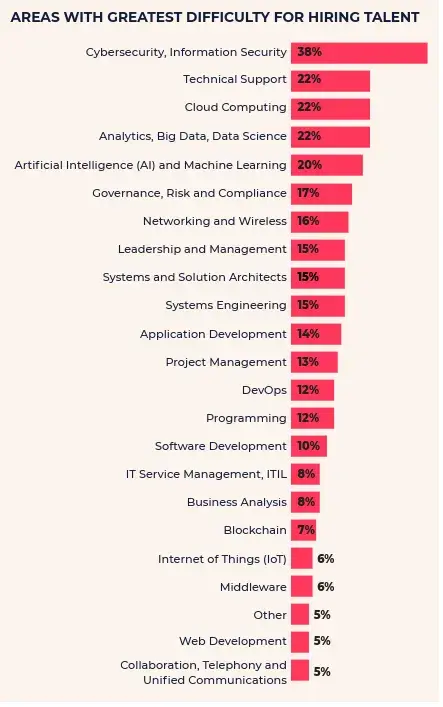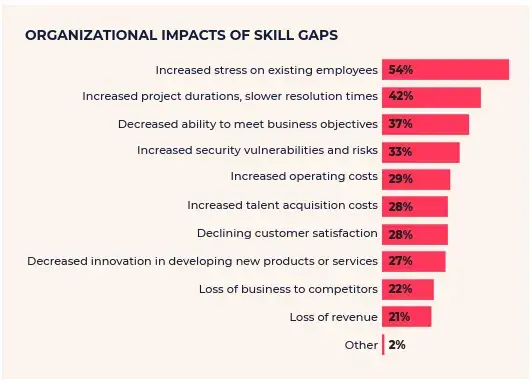
The IT Skills Gap: Strategies for Success in the Digital Economy
By 2030, the talent shortage and skills gap in the U.S. is expected to amount to $8.5 trillion in attributable unrealized revenue.1 There’s something eye-opening when you discover that the backbone of today’s businesses, technology, has a weak spot – a lack of people needed to keep everything running smoothly.

The IT skills gap is an issue that’s quietly been widening as digital transformation evolves, creating the need for specialized infrastructure management expertise. Companies are scrambling to find professionals who can manage cloud infrastructure, secure networks (inside and outside the firewall) and develop software that improves business processes. It’s more than a staffing issue; it is a fundamental obstacle to business growth.
The Shrinking Talent Pool
How did we get here? In the throes of the pandemic, more than 47 million Americans walked away from their jobs for better work-life balance, mental health and new opportunities, as part of the Great Resignation. Recently, in a shift called “the Big Stay,” workers are holding onto their jobs longer to avoid the risks associated with economic uncertainty.
Digital transformation has altered the landscape of what’s needed in the workforce. Entry-level positions are increasingly becoming automated, while people with skills in areas like artificial intelligence (AI) and machine learning (ML), cloud computing and networking are in high demand.
Take cybersecurity, for instance. Cyberattacks and data breaches are frequent enterprise challenges. But the supply of skilled security practitioners hasn’t kept pace with millions of unfilled positions globally. Likewise, demand for cloud computing, software development and IT infrastructure professionals continues to exceed supply.
The problem isn’t just the number of people available –it’s also the type of skills needed. The tech world evolves fast. Training, reskilling and upskilling efforts have struggled to keep pace. As much as 40% of the workforce will need to reskill within the next three years to adapt to ongoing technological innovations.3
A Pervasive Issue with Significant Impact

The impact of the skills gap is being felt across industries, creating a host of challenges. IT leaders are barely keeping their heads above water, trying to navigate the complexity of modern IT environments.
On top of day-to-day administration of on-premises data centers, now they must juggle interoperability requirements between third-party data center and cloud-based systems. Meanwhile, IT departments are overstretched. People burnout and find other jobs, and digital transformation initiatives flounder.
Of course, there’s a financial hit. According to IDC, by 2026 more than 90% of organizations worldwide will lose an estimated $5.5 trillion.4 These losses won’t just be from missed deadlines or product delays – they’ll come from businesses drowning in competition, unable to stay afloat with the rate of digital change.
Overcoming the Skills Gap
Businesses aren’t sitting back and hoping for the IT skills gap to magically close. They’re diving in and doing what they can to stay on course which, despite inherent challenges, includes reskilling and upskilling their existing teams. By offering training, certifications and mentorship, companies are doing what they can to ensure their workforce stays current.
They are also working to retain talent. That means creating a culture which recognizes the value IT teams bring to the company, committing to scheduling flexibility, and prioritizing family and a healthy work/life balance.
CoreSite is doing exactly that by providing cross-training for data center technicians, whose responsibilities necessitate being on-site. A future blog will go into our approach in more detail, but in a recent conversation, Joe Liccardo, Vice President of Operations said, “I want my people to know that if their son or daughter has a recital at 3 o’clock in the afternoon, they are going to be there. They aren’t stuck because no one else has the knowledge or skills needed to keep operations up and running.”
Colocation Can Make a Difference
Colocation in and of itself can help. By outsourcing IT infrastructure to data center and infrastructure experts, businesses can free internal resources and tap into third-party services like cloud platforms and managed IT.
Many businesses also turn to managed service providers to offload complex tasks, so internal teams can focus on improving core business processes. In an InfoBrief titled Enterprise Horizons 2024: Technology Leaders’ Priorities on their Digital Business Journey, IDC revealed that 49% of respondents were expecting to increase their use of MSPs to support with networking, 46% said cybersecurity solutions providers and 40% said cloud.
IT leaders see diminishing returns from dedicating scarce internal resources toward the day-to-day administration of on-premises data centers. They would much rather redirect their team’s efforts toward high-value tasks in support of the business. In the 2024 State of the Data Center Report by Foundry and CoreSite, one senior IT director in the banking industry summed up the situation by saying, “We’re not in the business of running a data center.”
The IT skills gap isn’t magically going away. As digital transformation ramps up, businesses must act fast and intentionally to stay competitive. By reskilling their teams, partnering with colocation data center providers, and leveraging managed services, companies will be better positioned to succeed in a fast-paced, tech-driven future.
Know More
Contact us to find out how CoreSite data center solutions can fill the gap with your internal teams and streamline your operations.
Learn what 300+ IT decision makers consider important to customers, partners and their enterprise. Download the 2024 State of the Data Center Report here.
References










